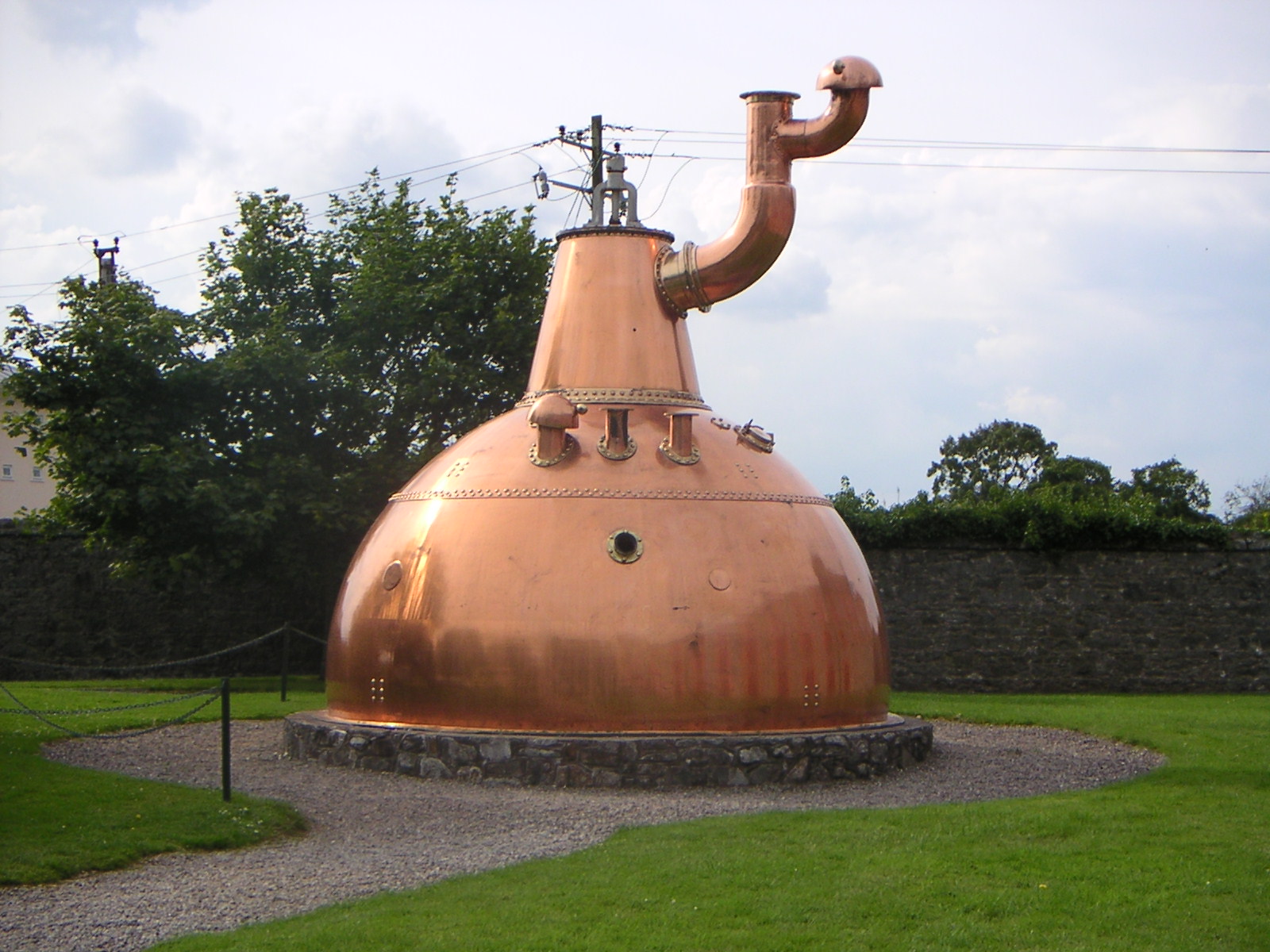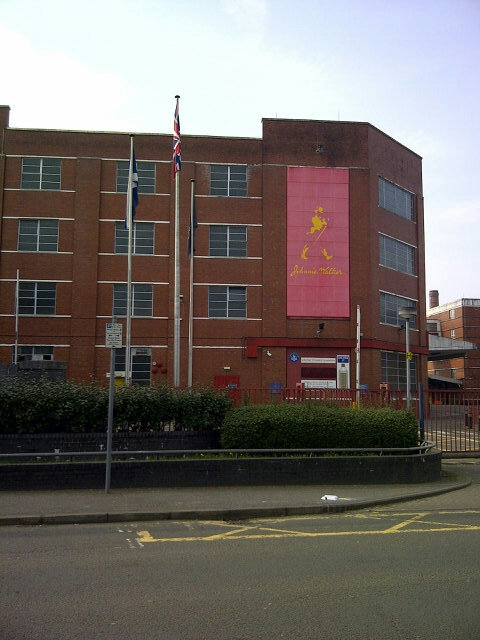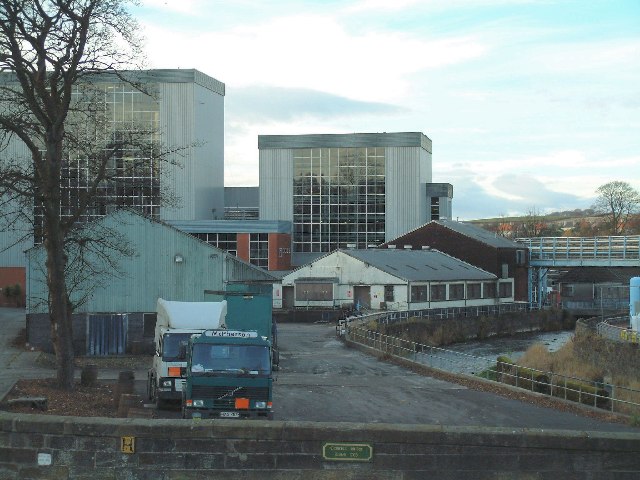|
Cameron Bridge
Cameron Bridge is a village in the conurbation of Levenmouth in Fife, Scotland. It is near to the village of Windygates and west of the town of Leven. A distillery was established in the 19th century by the Haig family, which is now part of Diageo. The distillery produces Scotch whisky. History and locality It is a settlement at a bridge over the River Leven, which replaced a ford there. When Leven was flooded it was the first upstream crossing. In 1870, an earlier bridge was replaced with a new one. The River Ore joins the Leven a little upstream of the village. Future transport A railway station could be located in Cameron Bridge in the future, which would also serve as at Park and Ride site. Rail freight provisions could also be provided to serve the distillery. This is as part of the Levenmouth rail link. The Cameronbridge Grain Distillery In 1824 the Haig distillery was opened. In 1830 it became the first distillery to produce Grain whisky using the Column still method ... [...More Info...] [...Related Items...] OR: [Wikipedia] [Google] [Baidu] |
Levenmouth
Levenmouth is a conurbation comprising a network of settlements on the north side of the Firth of Forth, in Fife on the east coast of Scotland. It consists of three principal coastal towns; Leven, Buckhaven, and Methil, and a number of villages and hamlets inland. The industrial towns of Buckhaven and Methil lie on the west bank of the River Leven, and the resort town of Leven is on the east bank. The "Bawbee Bridge" links the two sides of the river. Historically, Buckhaven and Methil were joined together as one burgh, while Leven was separate. The area had an estimated population of 37,238 in 2006. Levenmouth's economy has traditionally been focussed on heavy and traditional industries and has struggled economically since the closure of its coal mines. The main employers are Fife Scottish Omnibuses Ltd. Bi-Fab, Diageo, Donaldson Timber, Pfaudler Balfour and Silberline. History Toponymy The area is named after the mouth of the River Leven. The word 'Leven' comes from the Pi ... [...More Info...] [...Related Items...] OR: [Wikipedia] [Google] [Baidu] |
Pot Still
A pot still is a type of distillation apparatus or still used to distill liquors such as whisky or brandy. In modern (post-1850s) practice, they are not used to produce rectified spirit, because they do not separate congeners from ethanol as effectively as other distillation methods. Pot stills operate on a batch distillation basis (as contrasted with Coffey or column stills, which operate on a continuous basis). Traditionally constructed from copper, pot stills are made in a range of shapes and sizes depending on the quantity and style of spirit desired. Spirits distilled in pot stills top out between 60 and 80 percent alcohol by volume (ABV) after multiple distillations. Because of this relatively low level of ABV concentration, spirits produced by a pot still retain more of the flavour from the wash than distillation practices that reach higher ethanol concentrations. Under European law and various trade agreements, cognac (a protected term for a variety of brandy produced in ... [...More Info...] [...Related Items...] OR: [Wikipedia] [Google] [Baidu] |
Vat 69
Vat 69 is a blended Scotch whisky created by William Sanderson & Son Limited of South Queensferry, Scotland, now part of Diageo. History William Sanderson was born in Leith, Scotland January 27, 1839. He started an apprenticeship with wine and spirituous liquors producer Matthew Buchan at the age of 13. By 1863, he already owned his own business producing liqueurs and whisky blends. In 1880, his son William Mark joined the business and persuaded his father to bottle various blends of whisky. The famous Vat 69 bottle with its bulbous neck was introduced to the market and was not changed for the next hundred years. In 1882, William Sanderson prepared one hundred casks of blended whisky and hired a panel of experts to taste them. The batch from the cask (or “vat”) with number 69 was judged to be the best, and this provided the whisky's brand name. The whisky was at first bottled in port bottles. In 1884, Sanderson bought the Glen Garioch distillery which was situated in ... [...More Info...] [...Related Items...] OR: [Wikipedia] [Google] [Baidu] |
Black & White (whisky)
Black & White is a Blended whiskey, blended Scotch whisky. It was originally produced by the London-based James Buchanan & Co Ltd, which was founded by James Buchanan, 1st Baron Woolavington, James Buchanan. Initially known as House of Commons (after the British House of Commons), its nickname, referring to the black and white labelling, was eventually adopted as the official brand instead."A Black & White Scotch Whisky review" "Collins Pocket Reference:Whisky" via www.awa.dk. Article retrieved 2006-11-07. The brand's motif (featuring a black Scottish Terrier and a white West Highland White Terrier) was conceived by James Buchanan during the 1890s. [...More Info...] [...Related Items...] OR: [Wikipedia] [Google] [Baidu] |
Justerini & Brooks Whisky
Justerini & Brooks is a fine wine and spirits merchant founded in St. James's in 1749, originally to provide wine and spirits to the aristocratic households of London. The firm has been a supplier to every British monarch since the coronation of King George III in 1761. It sells to private collectors, hotels, and restaurants across the United Kingdom. Justerini & Brooks is owned by multinational Diageo. History Justerini and Brooks was founded in 1749 by Giacomo Justerini from Bologna, the son of a distiller, and English investor George Johnson. Together, they founded the wine merchants Johnson & Justerini. In 1760, Justerini returned to his native land after selling the business to Johnson. Johnson continued to grow the business, naming his grandson, Augustus, as a partner, and building relationships with European suppliers from Bordeaux, Cadiz, Mayence, Reims, Genoa, Dijon and Palermo. The firm received its first Royal Warrant from King George III the next year. In 1831, ... [...More Info...] [...Related Items...] OR: [Wikipedia] [Google] [Baidu] |
Johnnie Walker
Johnnie Walker is a brand of Scotch whisky now owned by Diageo that originated in the Scottish burgh of Kilmarnock in East Ayrshire. The brand was first established by grocer John Walker. It is the most widely distributed brand of blended Scotch whisky in the world, sold in almost every country, with annual sales of the equivalent of over 223.7 million 700 ml bottles in 2016 (156.6 million litres). History John Walker was born on 25 July 1805. His farmer father died in 1819, and the family sold the farm. Their trustees invested the proceeds, £417, in an Italian warehouse, grocery, and wine and spirits shop on the High Street in Kilmarnock, Ayrshire, Scotland. Walker managed the grocery, wine, and spirits segment as a teenager in 1820. The Excise Act of 1823 relaxed strict laws on distillation of whisky and reduced, by a considerable amount, the extremely heavy taxes on the distillation and sale of whisky. By 1825, Walker, a teetotaller, was selling spirits, inclu ... [...More Info...] [...Related Items...] OR: [Wikipedia] [Google] [Baidu] |
Gordon's Gin
Gordon's is a brand of London dry gin first produced in 1769. The top markets for Gordon's are the United Kingdom, the United States and Greece. It is owned by the British spirits company Diageo. It is the world's best-selling London dry gin. Gordon's has been the UK's number one gin since the late 19th century. A 40% ABV version for the North American market is distilled in Canada. History Gordon's London Dry Gin was developed by Alexander Gordon, a Londoner of Scots descent. <--''Website requires registration, 23 Apr 2015.'' He opened a distillery in the Southwark area in 1769, moving in 1786 to . The ''Special London Dry Gin'' he developed proved successful, and its recipe remains unchanged. Popular with the Royal Navy, bottles of the product were distributed all over the world. [...More Info...] [...Related Items...] OR: [Wikipedia] [Google] [Baidu] |
Tanqueray
Tanqueray is an English brand of gin produced by Diageo plc. It originated in London. In 2016 it displaced Beefeater as the number one global seller. While it does not command a sizable market share in its native market, its largest market is the United States, where it is the highest-selling gin import. Tanqueray is a London dry gin, reflecting its distillation process and origin in Bloomsbury, London. London dry gin is made by double distilling grain, with select botanicals added during the second distillation. While the Tanqueray recipe is a closely guarded trade secret, it is known to contain four botanicals: juniper, coriander, angelica root and liquorice, all common botanicals in gin productions overall. It is one of Diageo's sixteen "strategic brands" earmarked for prioritisation in promotion and distribution worldwide. History Tanqueray gin was initially distilled in 1830 by Charles Tanqueray in the Bloomsbury district of London. The retail outlet of Edward & Char ... [...More Info...] [...Related Items...] OR: [Wikipedia] [Google] [Baidu] |
Smirnoff
Smirnoff (; ) is a brand of vodka owned and produced by the British company Diageo. The Smirnoff brand began with a vodka distillery founded in Moscow by Pyotr Arsenievich Smirnov (1831–1898). It is distributed in 130 countries. Smirnoff products include vodka, flavoured vodka, and malt beverages. In 2014, Smirnoff was the best selling vodka around the world. The vodka is unaged made using a traditional filtration method developed by P. A. Smirnov. Recipe No. 21 was created by Smirnov's son Vladimir after escaping Russia during the October Revolution. History Pyotr Arsenyevitch Smirnov (9 January 1831 – 29 November 1898) founded his vodka distillery in Moscow under the trade name PA Smirnov in 1864, pioneered charcoal filtration in the 1870s, and by 1886 had captured two-thirds of the market in Moscow by virtue of the first use of newspaper advertising while suppressing clerical calls for temperance by generously contributing to the clergy. Russian royalty reportedly re ... [...More Info...] [...Related Items...] OR: [Wikipedia] [Google] [Baidu] |
Pimm's
Pimm's is an English brand of gin-based fruit cup but may also be considered a liqueur or the basis of a sling or punch. It was first produced in 1823 by James Pimm and has been owned by Diageo since 1997. Its most popular product is Pimm's No. 1 Cup, commonly used for the Pimm's cup cocktail. Serving Pimm's has a dark brown colour with a reddish tint, and a subtle taste of spice and citrus fruit. As a summer long drink, it is normally served as a Pimm's cup cocktail, a drink with "English-style" (clear and carbonated) lemonade, as well as various chopped garnishes, particularly apple, cucumber, orange, lemon, strawberry and mint or borage, though mint is more common. Ginger ale is used as a common substitute for lemonade. Pimm's can also be mixed with champagne (or other sparkling white wines), resulting in a drink known as a "Pimm's Royal Cup". Pimm's Winter Cup is generally mixed with warm apple juice. A "Glasgow Garden Party" is a drink made with Pimm's substituting lemon ... [...More Info...] [...Related Items...] OR: [Wikipedia] [Google] [Baidu] |
Schnapps
Schnapps ( or ) or schnaps is a type of alcoholic beverage that may take several forms, including distilled fruit brandies, herbal liqueurs, infusions, and "flavored liqueurs" made by adding fruit syrups, spices, or artificial flavorings to neutral grain spirits. The English loanword "schnapps" is derived from the colloquial German word ''Schnaps'' (plural: ''Schnäpse''), which is used in reference to spirit drinks. The word ''Schnaps'' stems from Low German and is related to the German term "''schnappen''", meaning "snap", which refers to the spirit usually being consumed in a quick slug from a small glass (i.e., a shot glass). European The German term ''Schnaps'' refers to "any kind of strong, dry spirit", similar to how ''eau de vie'' (water of life) is used in French, ''aguardiente'' (burning water) in Spanish, or ''aguardente'' Portuguese. ''Obstler'' ''Obstler'', or ''Obstbrand'' (from the German ''Obst'', fruit), are a traditional type of schnaps made by fermentin ... [...More Info...] [...Related Items...] OR: [Wikipedia] [Google] [Baidu] |
United Distillers
United Distillers was a Scottish company formed in 1987 from combining the businesses of Distillers Company and Arthur Bell & Sons, both owned by Guinness. The company owned six single malt Scotch brands, which were relaunched as the ''Classic Malts'' range. It also owned the Bernheim distillery (now owned by Heaven Hill) and the Stitzel-Weller distillery, both in Louisville, Kentucky in the United States. In 1997 Guinness merged with Grand Metropolitan to create Diageo, and in 1998 United Distillers was merged with International Distillers & Vintners to create United Distillers & Vintners, forming the spirits division of Diageo plc. In 2001 the company was renamed Guinness United Distillers & Vintners Scotland, and then renamed once again in 2002 to become Diageo Scotland (registered in Scotland, No. SC000750). See also * Guinness share-trading fraud The Guinness share-trading fraud was a major business scandal of the 1980s. It involved the manipulation of the London s ... [...More Info...] [...Related Items...] OR: [Wikipedia] [Google] [Baidu] |









